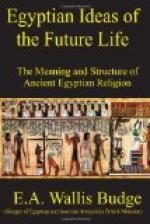of the funeral, or on that wherein it was laid in
the tomb. It is interesting to notice that no
mention is made of meat or drink in the CLIVth Chapter,
and the only thing which the deceased refers to as
necessary for his existence is air, which he obtains
through, the god Temu, the god who is always depicted
in human form; the god is here mentioned in his aspect
of the night Sun as opposed to R[=a] the day Sun,
and a comparison of the Sun’s daily death with
the death of the deceased is intended to be made.
The deposit of the head of the God-man Osiris at Abydos
has already been mentioned, and the belief that it
was preserved there was common throughout Egypt.
But in the text quoted above the deceased says, “My
head shall not be separated from my neck,” which
seems to indicate that he wished to keep his body whole,
notwithstanding that Osiris was almighty, and could
restore the limbs and reconstitute the body, even
as he had done for his own limbs and body which had
been hacked to pieces by Set. Chapter XLIII of
the Book of the Dead [Footnote: See
The Chapters
of Coming Forth by Day, p. 98.] also has an important
reference to the head of Osiris. It is entitled
“The Chapter of not letting the head of a man
be cut off from him in the underworld,” and
must be of considerable antiquity. In it the
deceased says: “I am the Great One, the
son of the Great One; I am Fire, and the son of the
Fire, to whom was given his head after it had been
cut off. The head of Osiris was not taken away
from him, let not the head of the deceased be taken
away from him. I have knit myself together (
or
reconstituted myself); I have made myself whole and
complete; I have renewed my youth; I am Osiris, the
lord of eternity.”
From the above it would seem that, according to one
version of the Osiris story, the head of Osiris was
not only cut off, but that it was passed through the
fire also; and if this version be very ancient, as
it well may be and probably is, it takes us back to
prehistoric times in Egypt when the bodies of the
dead were mutilated and burned. Prof. Wiedemann
thinks [Footnote: See J. de Morgan, Ethnographie
Prehistorique, p. 210.] that the mutilation and
breaking of the bodies of the dead were the results
of the belief that in order to make the KA, or “double,”
leave this earth, the body to which it belonged must
be broken, and he instances the fact that objects
of every kind were broken at the time when they were
placed in the tombs. He traces also a transient
custom in the prehistoric graves of Egypt where the
methods of burying the body whole and broken into
pieces seem to be mingled, for though in some of them
the body has been broken into pieces, it is evident
that successful attempts have been made to reconstitute
it by laying the pieces as far as possible in their
proper places. And it may be this custom which
is referred to in various places in the Book of the
Dead, when the deceased declares that he has collected
his limbs “and made his body whole again,”
and already in the Vth dynasty King Teta is thus addressed—“Rise
up, O thou Teta! Thou hast received thy head,
thou hast knitted together thy bones, [Footnote:
Recueil de Travaux, tom. v. p. 40 (I. 287).]
thou hast collected thy members.”




